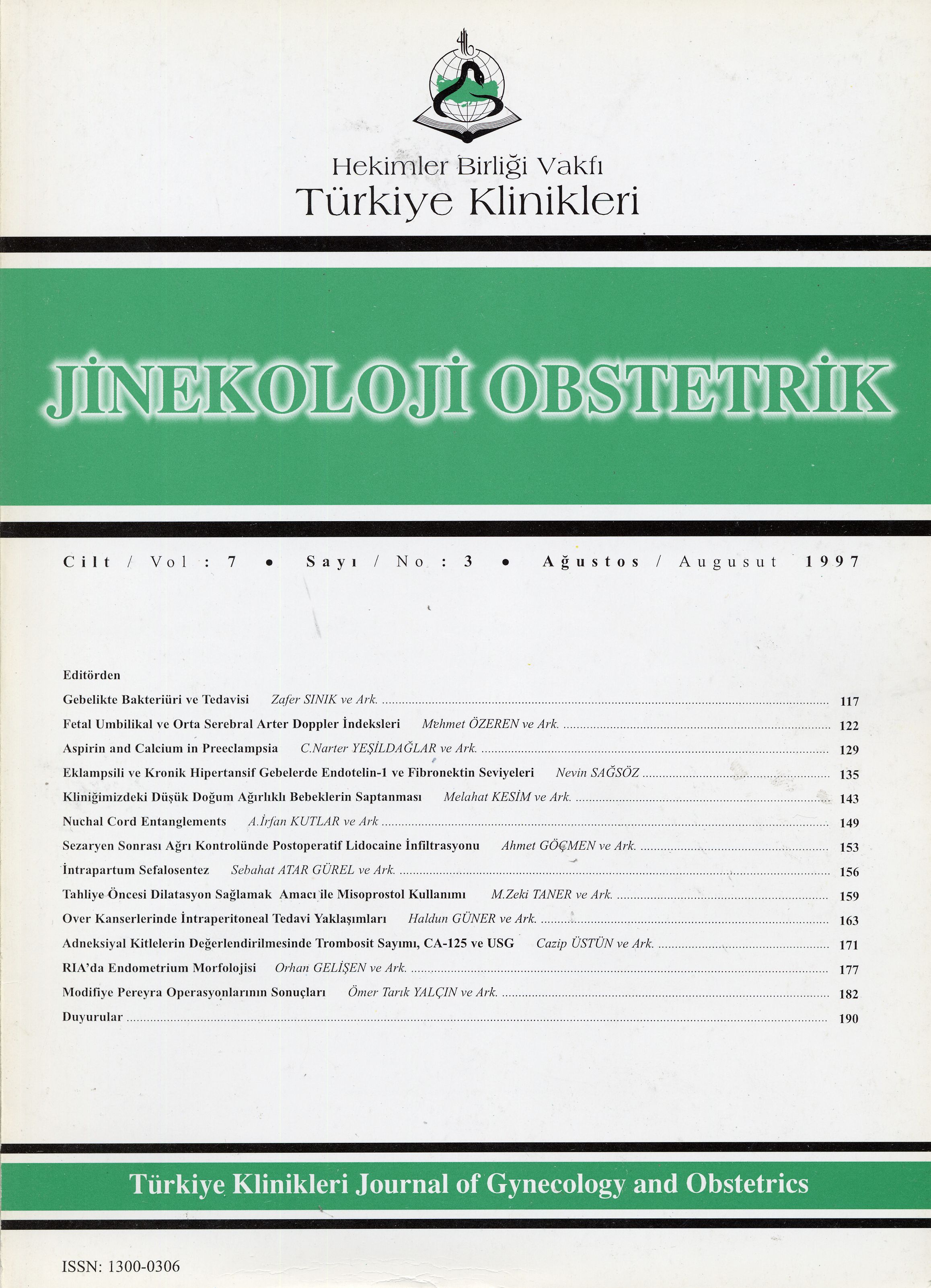Open Access
Peer Reviewed
ARTICLES
2001 Viewed1080 Downloaded
Sezaryen Sonrası Ağrı Kontrolünde Postaperatif lidocaine İnfiltrasyonu
Sezaryen Sonrası Ağrı Kontrolünde Postaperatif lidocaine İnfiltrasyonu
Turkiye Klinikleri J Gynecol Obst. 1997;7(3):153-5
Article Language: TR
Copyright Ⓒ 2025 by Türkiye Klinikleri. This is an open access article under the CC BY-NC-ND license (http://creativecommons.org/licenses/by-nc-nd/4.0/)
ÖZET
Amaç: Sezaryenden sonra ağrının kontrolünde postoperatif lidocaine infiltrasyonunu etkinliğini araştırmak Çalışmanın Yapıldığı Yer: Dicle Üniversitesi Tıp Fakültesi Kadın Hastalıkları ve Doğum ABD, Diyarbakır. Materyal ve Metod: Sezaryen uygulanan 50 hasta iki gruba ayrılarak yarısına genel anestezi, yarısına genel anesteziye ilave olarak lokal anestezi uygulanarak postoperatif ağrı değerlendirildi. Yirmibeş olguya (grup I) cilt kapatılmadan önce rektus fasiyası ve subkütan dokuya %1 Lidocaine verilirken, yirmi beş olguya (grup II) normal salin solusyonu verildi. Bulgular: Lidocaine grubunda ağrı anlamlı olarak düşük bulundu (p<0.001). Postoperatif ilk analjezi için gerekli süre lidocaine grubunda anlamlı derecede uzun bulundu(p<0.001). Postoperatif 24. saatte ağrı skoru lidocaine grubunda anlamlı ölçüde düşük tesbit edildi(p<0.001). Sonuç: Sonuç olarak, sezaryende postoperatif ağrının kontrolünde lokal anestezi kullanılması etkili olan ve postoperatif analjezi ihtiyacını azaltan bir yöntemdir.
ANAHTAR KELİMELER: Lokal Anestezikler, Postoperatif ağrı, Sezaryen
ABSTRACT
Objective: To assess the effect of postoperative lidocaine infiltration on the control of postoperative pain Institution: Dicle University, Medical Faculty, Obstetrics and Gynecology Department, Diyarbakır Material and Method: Postoperative pain was assessed in 50 patients undergoing cesarean section with two types of anesthesia; general and general with the addition of local. Twenty-five patients (group I) received lidocaine in the rectus fascia and subcutanous tissue before skin closure, twenty-five patients (group II) received placebo normal saline solution. Results: The lidocaine treated group had significantly lower pain scores(p<0.001). Median time to postoperative analgesic request was significantly longer in the local anesthetic group (p<0.001). Conclusion: In conclusion, lidocaine used as local anesthetic is effective to decrease of postoperative pain and analgesic requirements.
Objective: To assess the effect of postoperative lidocaine infiltration on the control of postoperative pain Institution: Dicle University, Medical Faculty, Obstetrics and Gynecology Department, Diyarbakır Material and Method: Postoperative pain was assessed in 50 patients undergoing cesarean section with two types of anesthesia; general and general with the addition of local. Twenty-five patients (group I) received lidocaine in the rectus fascia and subcutanous tissue before skin closure, twenty-five patients (group II) received placebo normal saline solution. Results: The lidocaine treated group had significantly lower pain scores(p<0.001). Median time to postoperative analgesic request was significantly longer in the local anesthetic group (p<0.001). Conclusion: In conclusion, lidocaine used as local anesthetic is effective to decrease of postoperative pain and analgesic requirements.
MENU
POPULAR ARTICLES
MOST DOWNLOADED ARTICLES





This journal is licensed under a Creative Commons Attribution-NonCommercial-NoDerivatives 4.0 International License.










